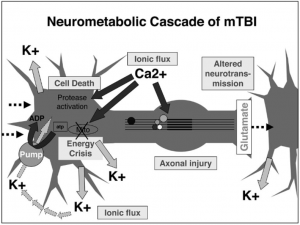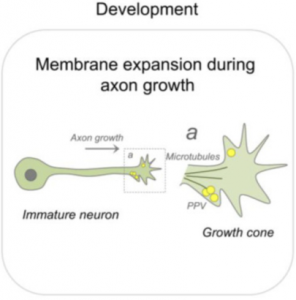Have you ever had a concussion? Whether it be due to a sports injury or fall, concussions are one of the most common mild traumatic brain injuries (mTBIs), and the way your body handles them can differ based off your age, genetics, and the frequency in which you suffer TBIs. (Giza & Hovda, 2014).
This can make determining when you’ve recovered from a concussion difficult, but luckily, a lot is already known regarding how neurons are impacted and work to recover from concussions. As seen in Figure 1 below, mTBIs cause an influx of cations into neurons, inducing an energy crisis where ATP-requiring pumps shift into overdrive, eventually causing the sequestration of calcium within cellular mitochondria. This causes the mitochondria to become dysfunctional, thereby preventing the energy powerhouse of the cell from doing its job. Thus, restoration of ATP amounts is needed to recovery from a concussion (Giza & Hovda, 2014). For a deeper dive into the effects of mTBI on a neuron illustrated in Figure 1, click here.

Figure 1 – What occurs in a neuron after a mild traumatic brain injury (mTBI), such as a concussion (Giza & Hovda, 2014).
Axonal Regeneration
Aside from the need to restore the amount of ATP within a neuron to what is needed to fuel neuronal machinery, the regeneration of a neuron’s axon is vital to neuronal regeneration. Membrane lipids, specifically phospholipids, glycolipids, and cholesterol, make up a large part of axons. As seen in Figure 2, normal axon growth involves these newly synthesized lipids being transported from a neuron’s cell body to an axon’s growth cone, where lipids fuse with the acceptor membrane and expand the membrane (Roy & Tedeschi, 2021).

Figure 2 – this is an illustration of the growth cone that forms and lengthens an axon during neuron development/membrane expansion. (Roy & Tedeschi, 2021).
After severing of an axon, rapid sealing of disrupted membrane is necessary to restore the integrity of the axonal compartment. As seen in Figure 3, this involves phospholipids inserting themselves to create a new membrane in the area where the axon is severed, creating a new growth cone by restoring the axonal lipid bilayer. Not explicitly seen in Figure 3 but needed are glycolipids, which allow specific signal transduction and contribute membrane stability to axons, and cholesterol, which makes up a large component of the myelin sheath around axons that speeds of signal transmission (Roy & Tedeschi, 2021). Since membrane lipids are needed in axonal, and therefore neuronal, regeneration post-concussion, research into neuronal lipid homeostasis re-establishment has potential to progress society’s approach to treating concussions. More specifically, the ingestion of dietary lipids is a field of study being investigated as a route to treat concussions (Giza & Hovda, 2014).

Figure 3 – the top illustration shows how phospholipids made up the lipid bilayer of the neuronal membrane and what occurs if that membrane is disrupted, like during mTBIs. The bottom illustration displays what the myelin sheath and axonal membrane look like immediately after a TBI and then during axonal regeneration (Roy & Tedeschi, 2021).
Barriers to Understanding
But despite our knowledge of how phospholipids, glycolipids, and cholesterol contribute to axonal regeneration, current research has shown that administration of cholesterol-lowering drugs has conflicting impacts on axonal membrane and myelin sheath regeneration (Roy & Tedeschi, 2021). This challenge is significant in the field of TBI recovery because both the axonal membrane and myelin sheath, which contain cholesterol, are integral parts of a neuron in propagating an electrochemical signal and allowing efficient neuronal communication. Also, it begs the question: do other membrane lipid-altering drugs have conflicting impacts on neuronal regeneration?
Future Research & Its Potential Impact in Medicine
Therefore, current research into if and how administration/ingestion of dietary fatty acids can promote axon regeneration is being done, but it must be advanced. Two findings that address this challenge include:
- A study showed that increased expression of lipin 1, an enzyme that increases storage of lipids as triglycerides, contributed to failure to regenerate axons because it did not produce the phospholipids necessary for membrane expansion. Furthermore, depletion of lipin 1 promoted axonal regeneration (Roy & Tedeschi, 2021). This presents a new pathway for research, where a lipin 1 protease (degradation enzyme) or fatty acid that increases phospholipid levels may be investigated as helpful in promoting axonal recovery.
- It was found that lowering cholesterol promoted CNS axonal regeneration but negatively impacted myelin formation and repair (Roy & Tedeschi, 2021). Therefore, a research pathway that can be investigated is determining if cholesterol or cholesterol-containing fatty acids can be delivered with a spatial and temporal precision that promotes both axon and myelin regeneration.
For a description of the studies that concluded the findings upon which these research proposals are based, click here.
Answering these questions would broaden our understanding of the role of lipids in axonal regeneration, which would help us determine whether decisions such as the food we eat when recovering from a concussion can promote quicker and more effective neuronal regeneration. This can help ensure that our brains keep as many neurons as possible from dying, which would prevent the cognitive deficits seen after some TBI cases. If research supporting the ingestion of specific foods whilst recovering from concussion or other injuries came out, how would this impact what insurance policies cover, cost of healthcare regarding TBI recovery, and what physicians can prescribe as treatments?
Overall, research has shown that the most effective interventions and treatments for TBI are yet to be determined, but diet is a research area that has shown potential promise to yield recovery advice that does not need to be medically prescribed. Whether or not insurance would cover the cost of foods containing recovery-promoting lipids/other molecules is unknown, but the cost of that food is likely to be less than any prescription medications that could be prescribed, so advancement in our knowledge has potential to allow more accessible recovery from concussions. To learn more about the role of lipids in axon growth and regeneration after central nervous system injury, visit: https://pubmed.ncbi.nlm.nih.gov/34062747/
Footnotes:
1Giza, C., Hovda, D. “The New Neurometabolic Cascade of Concussion.” Congress of Neurological Surgeons, vol. 75, no. 4, 2014, pp. 524-533.
2Roy, D., Tedeschi, A. “The Role of Lipids, Lipid Metabolism and Ectopic Lipid Accumulation in Axon Growth, Regeneration and Repair after CNS Injury and Disease.” Cells, vol 10, no. 5, 2021, doi: 10.3390/cells10051078.